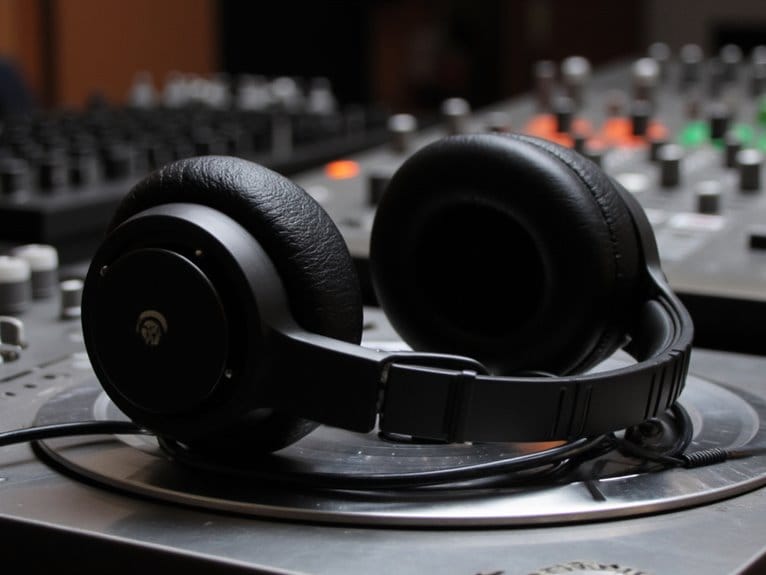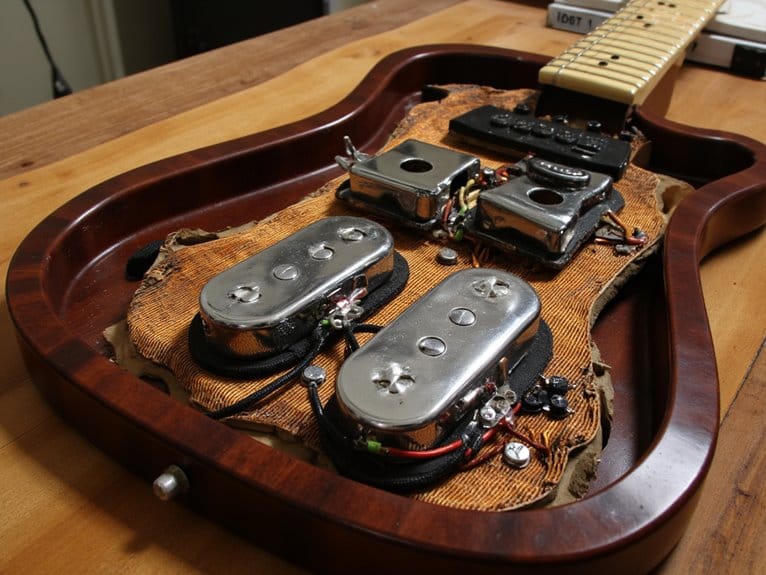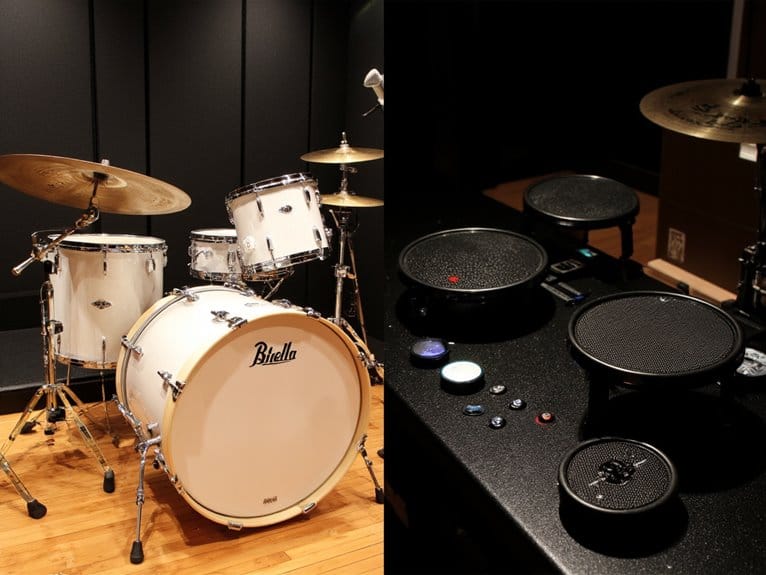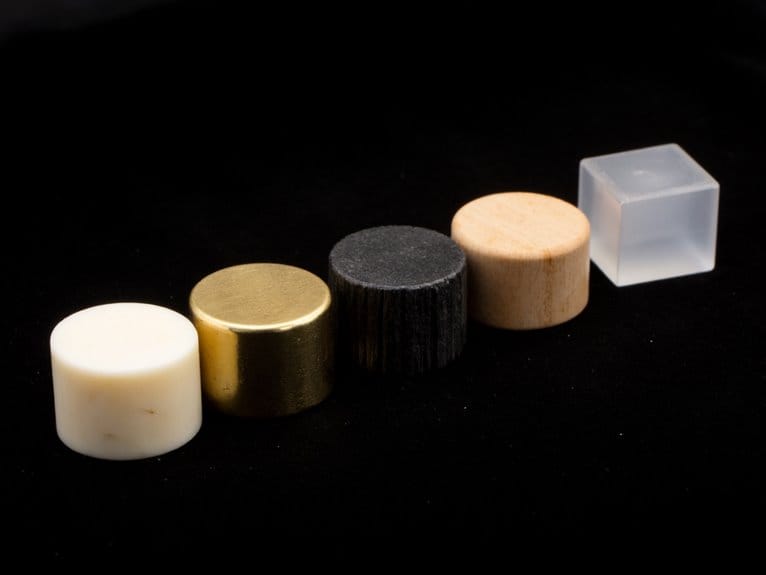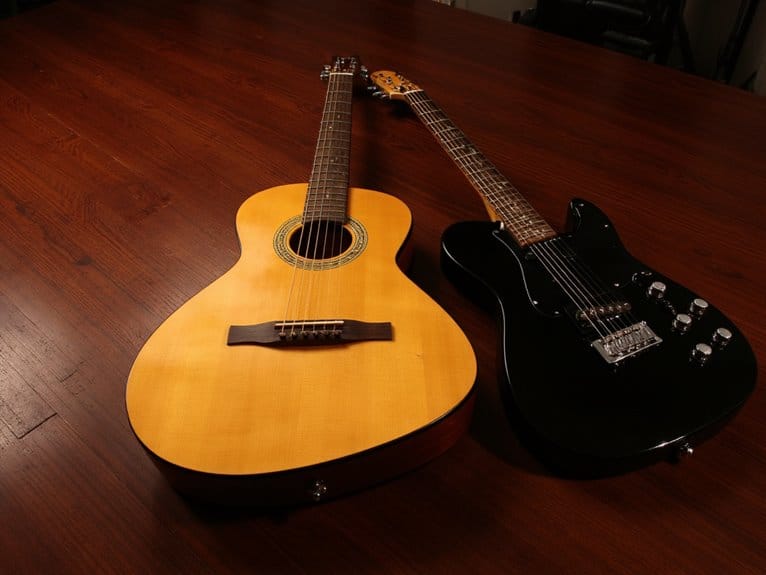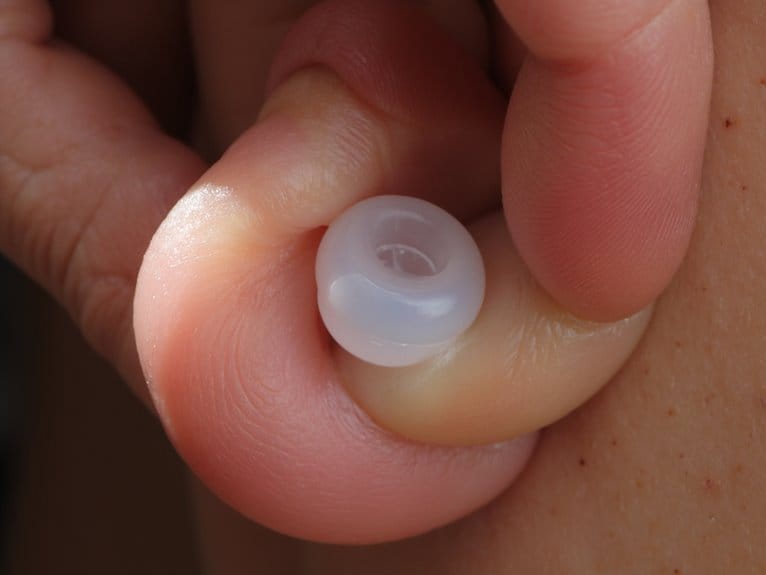DJ Headphones: What Makes Them Different
DJ headphones differ considerably from regular models through their specialized 40-50mm drivers that deliver enhanced bass response and boosted treble for beatmatching precision, while closed-back designs provide superior noise isolation in loud club environments. You’ll find swiveling ear cups for single-ear monitoring, reinforced construction with replaceable parts for durability, and frequency tuning that prioritizes punchy low-end over neutral reproduction. These performance-focused features reveal professional mixing capabilities that separate them from consumer alternatives.
We are supported by our audience. When you purchase through links on our site, we may earn an affiliate commission, at no extra cost for you. Learn more.
Notable Insights
- DJ headphones feature swiveling ear cups for single-ear monitoring during live performances, unlike fixed studio headphones.
- Closed-back design with specialized acoustic foam provides superior sound isolation to block loud club environments effectively.
- Enhanced bass response and boosted treble frequencies aid beatmatching while keeping vocals prominent for mixing accuracy.
- Durable construction with replaceable parts like ear pads and detachable cables withstands intensive live performance use.
- Large 40-50mm drivers with optimized impedance around 24 ohms deliver powerful, clear sound reproduction for professional mixing.
Enhanced Audio Quality and Driver Technology
When you’re spinning tracks in a packed club where the bass is thumping and voices are competing for attention, the quality of your headphones becomes absolutely critical to your performance.
DJ headphones typically feature drivers ranging from 40mm to 50mm, with larger units delivering better bass response and fuller sound reproduction that’s essential for monitoring low-end elements.
The driver calibration in quality models guarantees precise left and right channel separation, allowing accurate track cueing and seamless blending between songs.
With high sensitivity ratings around 98 dB and optimized impedance levels near 24 ohms, these headphones maintain exceptional audio fidelity while connecting effortlessly to various DJ equipment without requiring additional amplification, guaranteeing your mixes translate accurately from booth to dance floor.
Professional models extend their frequency response up to 40 kHz to capture the finest audio details across the entire spectrum. The closed-back design effectively blocks ambient noise and prevents sound leakage, ensuring accurate monitoring even in loud environments.
While professional DJ headphones offer superior monitoring capabilities, many DJs are now incorporating in-ear monitors as portable alternatives that can cut through loud club environments while providing exceptional mobility during performances.
The coiled cable design, typically extending up to 9 feet when fully stretched, provides DJs with the mobility needed to move freely between turntables and mixing equipment without cable tension restrictions.
Built for Durability and Heavy Use
Professional DJing demands equipment that can survive countless gigs, late-night sessions, and the inevitable accidents that come with performing in crowded venues where drinks get spilled and gear gets knocked around.
DJ headphones incorporate durable materials like high-grade nylon, carbon fiber, and reinforced plastics that resist drops and pressure while maintaining structural integrity through metal components in critical joints.
The ergonomic design features lightweight construction weighing 160-250 grams, memory foam ear cushions, and adjustable padded headbands that accommodate extended wear without fatigue.
You’ll find easily replaceable ear pads and detachable cables that prevent total replacement after minor damage, while swiveling ear cups enable single-ear monitoring during active mixing sessions in demanding environments.
Superior Noise Isolation in Loud Environments
When you’re spinning tracks in a packed nightclub where bass lines thump through walls and conversations compete with your mix, you’ll quickly realize that superior noise isolation isn’t just a luxury-it’s absolutely essential for maintaining your performance quality.
I’ve found that the closed-back design of professional DJ headphones creates a sealed acoustic environment that blocks external club noise while simultaneously preventing your music from leaking out and disturbing nearby patrons or fellow performers.
You need headphones that can effectively isolate your monitoring signal from the chaotic sound environment around you, ensuring that every beat shift, EQ adjustment, and track selection remains precisely controlled despite the overwhelming ambient noise levels.
Professional models typically feature larger drivers ranging from 40-60mm that enhance both audio quality and sound isolation capabilities, making them particularly effective in demanding live performance environments.
Closed-Back Design Benefits
The cacophony of a bustling nightclub or crowded studio can easily overwhelm anyone trying to focus on their mix, but closed-back DJ headphones create an acoustic sanctuary that blocks out the chaos around you. These sealed ear cups prevent external noise from seeping in while keeping your audio from leaking out, which explains why virtually every professional DJ swears by this design for live performances.
| Feature | Benefit | Performance Impact |
|---|---|---|
| Sealed Construction | Blocks ambient noise | Enhanced focus during mixing |
| Bass Enhancement | Richer low-frequency response | Better sound dynamics perception |
| Zero Leakage | Private monitoring | Meets user preferences for discretion |
The closed-back architecture delivers passive noise cancellation that’s particularly effective in high-decibel environments, allowing you to hear subtle details in your tracks without cranking up dangerous volume levels.
Blocking External Club Noise
How can you possibly maintain focus on intricate beatmatching when thunderous bass lines, screaming crowds, and overlapping sound systems create an overwhelming wall of noise that’d make even seasoned DJs question their sanity?
Professional DJ headphones tackle this chaos through sophisticated active cancellation technology, employing dual microphone systems that monitor ambient sound and generate opposing frequencies to neutralize club din.
You’ll notice how feed-forward and feedback ANC work together, targeting everything from low-frequency bass rumble to mid-range crowd chatter, while specialized acoustic foam within the ear cups provides additional passive isolation.
This combination allows precise external monitoring without cranking volumes to dangerous levels, protecting your hearing during those marathon sets while maintaining the crystal-clear audio separation essential for seamless mixing.
Preventing Sound Leakage Issues
Sound leakage transforms even the most expensive DJ headphones into useless monitoring tools when your perfectly cued track becomes audible to everyone within a fifteen-foot radius, effectively broadcasting your next move to both the crowd and competing DJs who’d love nothing more than to anticipate your changes. Professional DJs rely on advanced isolation techniques that combine over-ear designs with specialized materials like PU leather and Alcantara® memory foam earpads, which conform precisely to your ear shape while preventing outward sound bleeding.
| Isolation Feature | Benefit |
|---|---|
| Over-ear encapsulation | Prevents outward leakage |
| Memory foam seals | Blocks ambient penetration |
| Modular ear pad design | Maintains isolation integrity |
| Engineered housing structure | Maximizes sound containment |
These isolation techniques enable lower monitoring volumes while maintaining crystal-clear track separation.
Optimized Features for Live Mixing and Performance
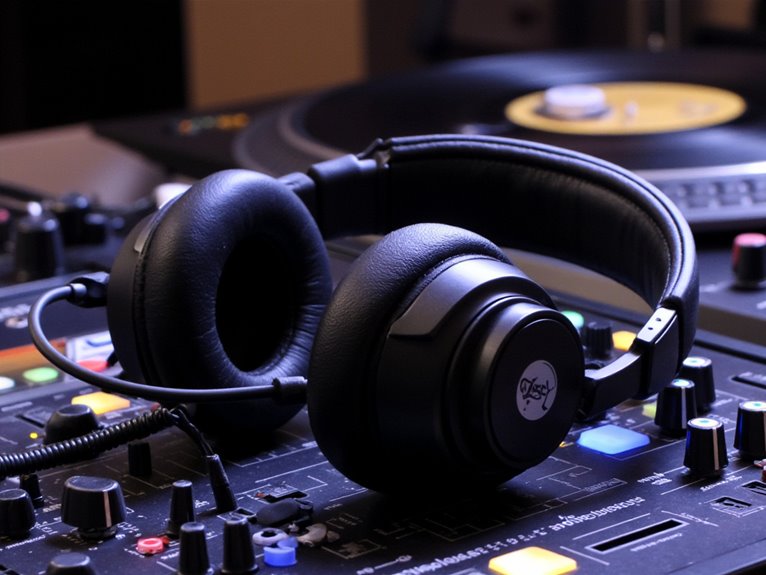
Professional DJing demands headphones that don’t just sound good-they need to perform flawlessly under the intense pressure of live mixing, where split-second timing and crystal-clear audio reproduction can make or break a set.
You’ll find that purpose-built DJ headphones incorporate several performance-optimized features that distinguish them from consumer models.
The most critical performance enhancements include:
- Ultra-low latency wireless connectivity – Models like AIAIAI TMA-2 DJ Wireless deliver sub-10ms latency with 320kbps Bluetooth transmission, ensuring imperceptible delay during beatmatching.
- Modular design flexibility – Swappable components allow wireless upgrades and maintenance without replacing entire units.
- Extended battery life – Up to 20 hours of continuous wireless operation eliminates mid-set failures.
These features, combined with ergonomic construction for personalized fit, create headphones that adapt to your mixing style rather than limiting it.
Key Differences From Studio Headphones
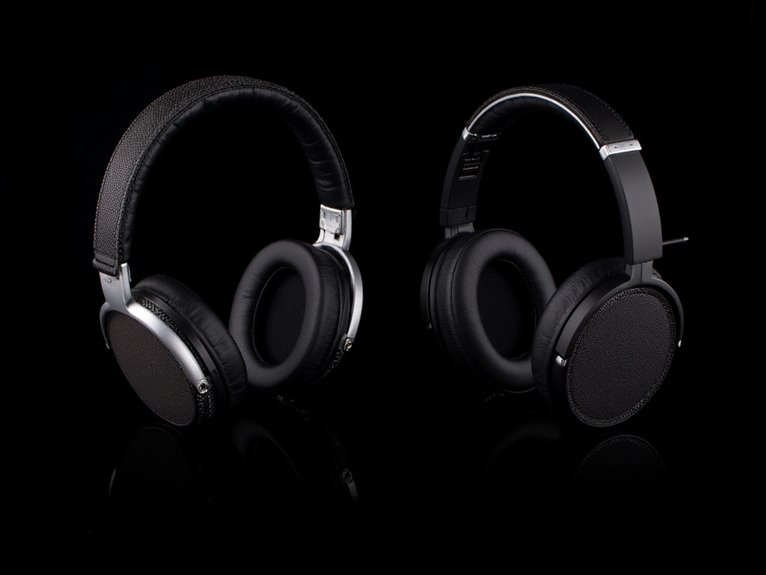
When you’re choosing between DJ and studio headphones, you’ll notice they’re engineered for completely different purposes, which affects everything from their frequency response characteristics to their physical design priorities.
DJ headphones typically emphasize enhanced bass response and superior sound isolation to help you perform effectively in loud club environments, while studio headphones focus on delivering flat, accurate frequency reproduction for precise audio monitoring during recording sessions.
Understanding these fundamental differences in frequency tuning, structural design, and isolation capabilities will help you select the right headphones for your specific audio work, whether you’re mixing tracks at a festival or producing music in your home studio. Studio headphones often feature wide frequency response ranges supporting 20 Hz to 40 kHz to capture detailed audio nuances essential for music production.
Professional DJ headphones often feature rotating ear cups for single-ear monitoring, allowing DJs to listen to both the live mix and upcoming track simultaneously during live performances.
Frequency Response Purpose
The battle between accuracy and performance defines the fundamental frequency response differences that separate DJ headphones from their studio counterparts, and I’ve spent countless hours testing both types to understand why each takes such a dramatically different approach.
Your frequency response tuning needs depend entirely on whether you’re creating music or performing it live, and frankly, I learned this lesson the hard way during my first club gig.
DJ headphones deliberately boost specific frequencies to meet performance needs in challenging environments:
- Enhanced bass response helps you clearly identify kick drums and basslines for precise beatmatching
- Boosted treble frequencies cut through ambient noise, making hi-hats and cymbals audible
- Shaped midrange guarantees vocals remain prominent without overwhelming essential low-end elements
Design and Isolation
Beyond frequency response tuning, DJ headphones incorporate specific design elements that fundamentally separate them from studio models, and I’ve discovered that these physical differences matter just as much as sound signature when you’re performing in demanding environments.
| Design Feature | Studio Headphones | DJ Headphones |
|---|---|---|
| Earcup Movement | Fixed position | Swiveling earcups for single-ear monitoring |
| Build Priority | Accuracy focus | Durable materials for performance enhancements |
| Comfort Design | Light padding | Padded comfort with adjustable headbands |
The ergonomic design prioritizes DJ portability while maintaining hearing health through superior noise blocking capabilities. These headphones prevent sound leakage that could disrupt your performance, unlike studio models where isolation isn’t paramount. The closed-back construction creates an acoustic barrier that studio headphones simply can’t match in club environments.
Frequently Asked Questions
What Is the Typical Price Range for Quality DJ Headphones?
You’ll find quality DJ headphones ranging from $60-$150 for entry-level, $150-$399 for mid-range, and $369-$1,200 for high-end models. Budget considerations and preferred headphone brands greatly influence your final investment decision.
Are Wireless DJ Headphones as Reliable as Wired Ones for Performances?
You’ll find wireless reliability isn’t quite matched to wired for performances due to potential battery failures and signal dropouts. While sound quality has improved considerably, wired headphones still offer superior audio fidelity.
On a final note
You’ve now got the knowledge to understand why DJs swear by specialized headphones rather than settling for consumer models. Whether you’re spinning tracks at weekend house parties or considering a professional setup, these headphones deliver the durability, isolation, and mixing features that’ll elevate your performance. Don’t compromise on gear that’s built specifically for the demands you’ll face behind the decks.

